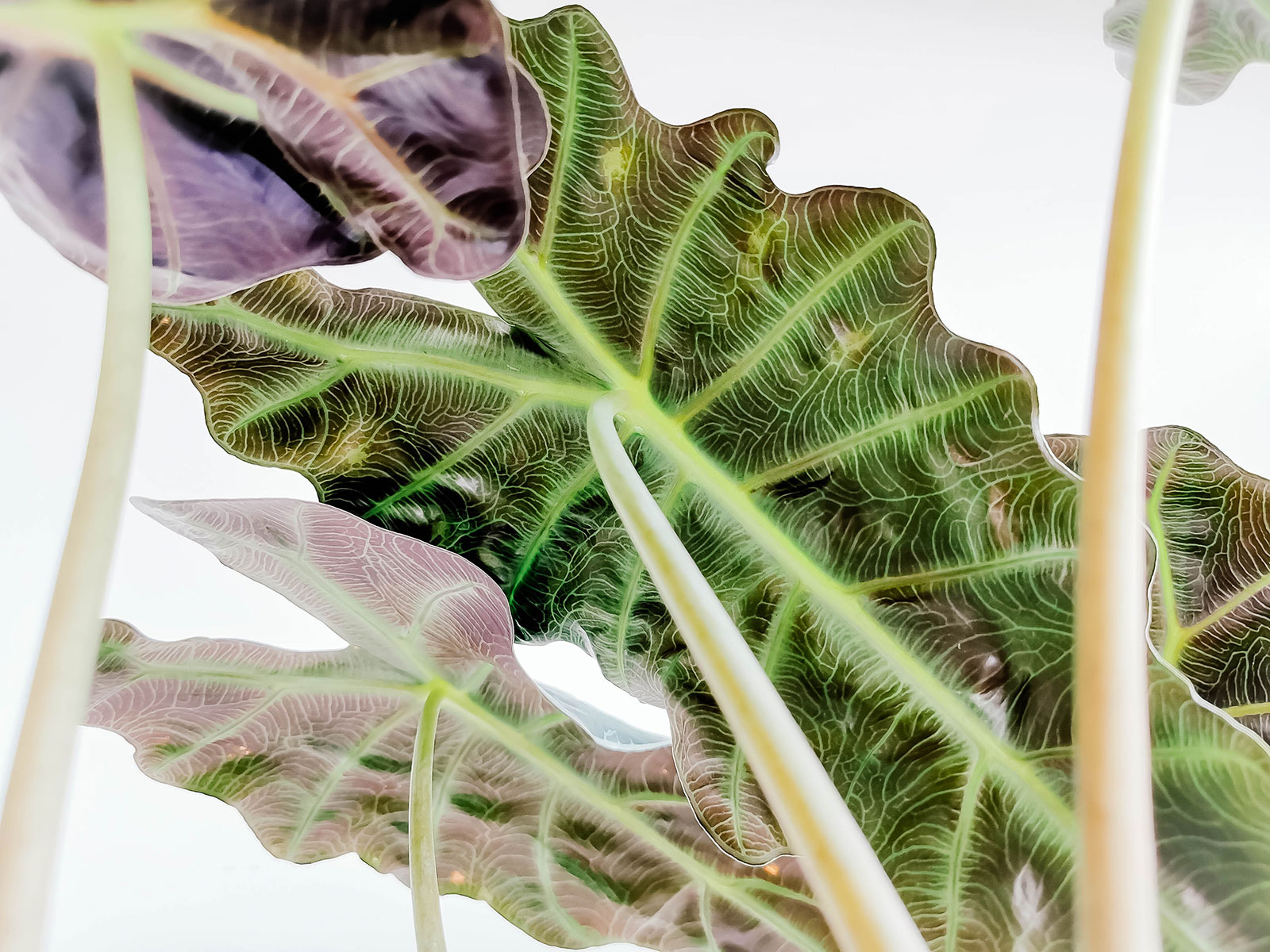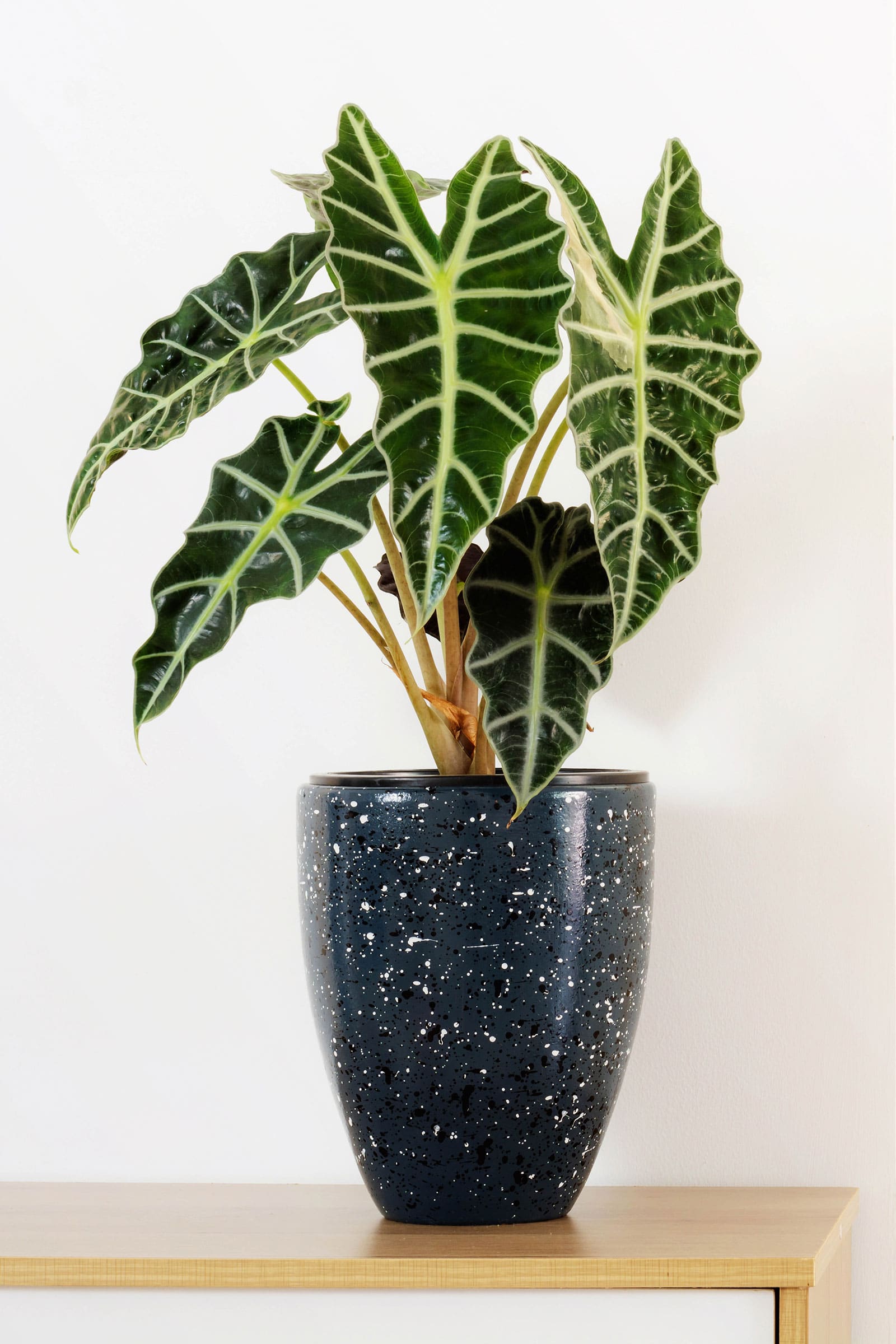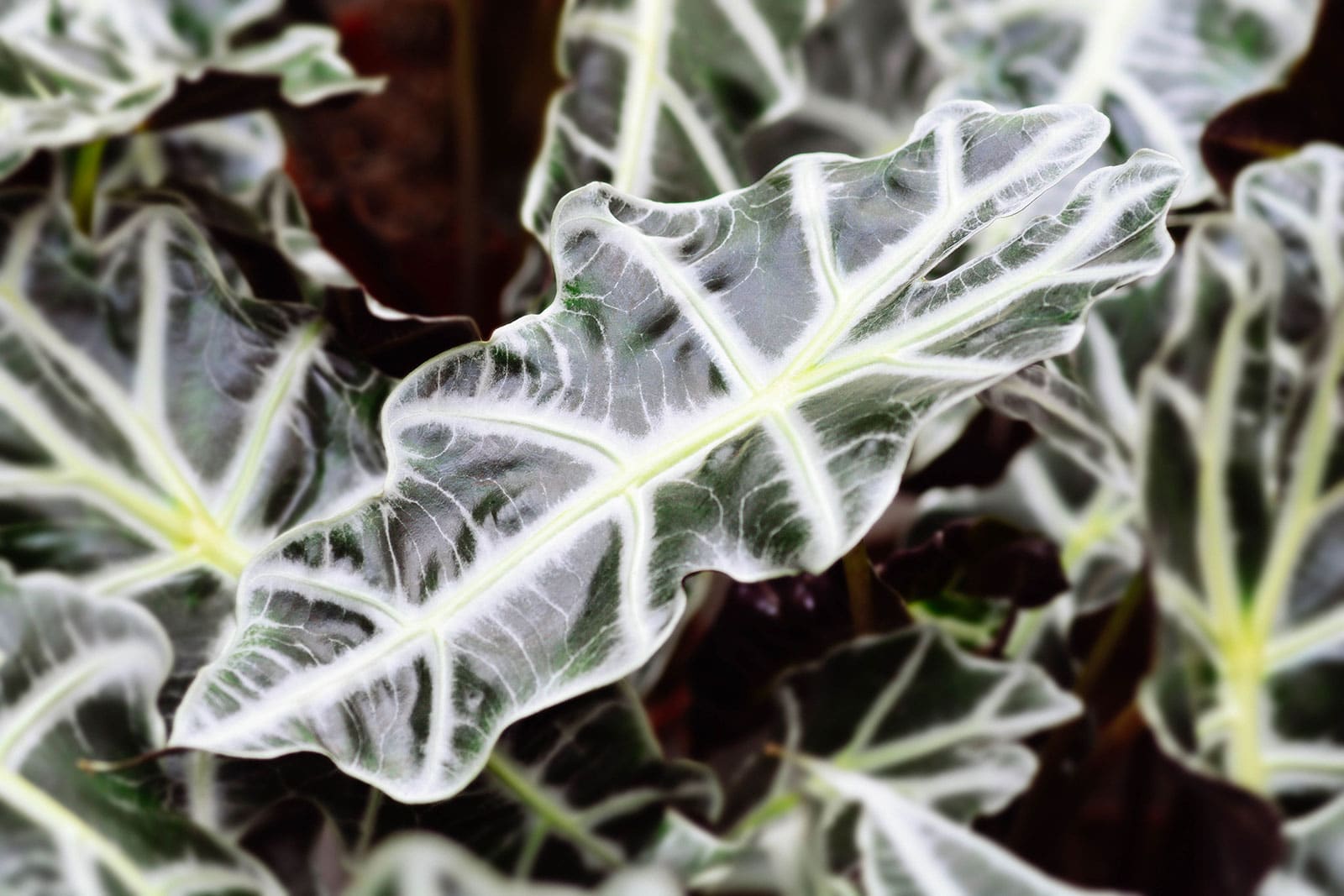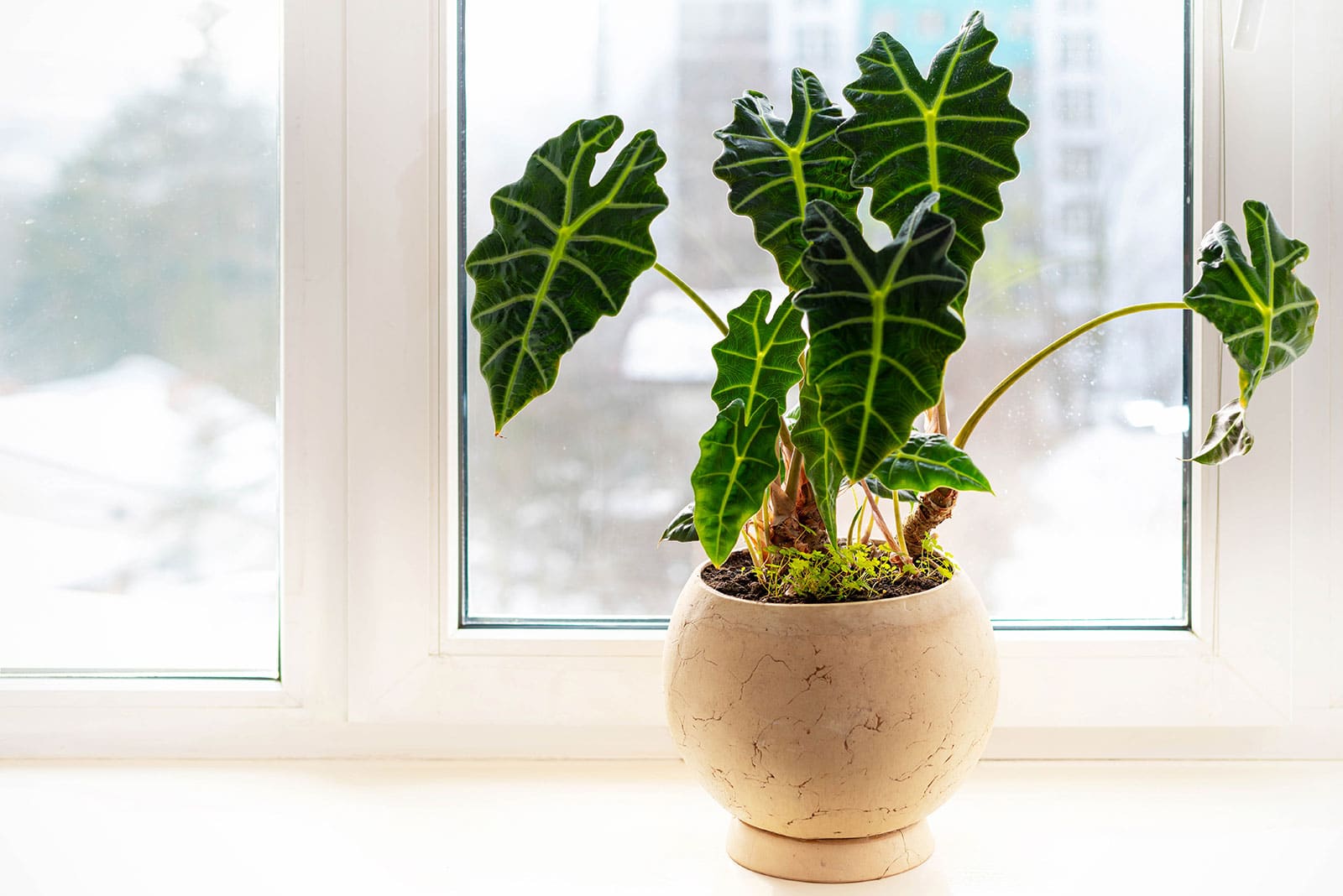Looking for a spectacular houseplant that really catches the eye? It’s hard to go wrong with the genus Alocasia, especially a relatively recent cultivar known as Alocasia amazonica ‘Polly’. All of the flair of its parent plant, Alocasia amazonica, but in a more compact package perfect for smaller spaces!
Keep reading for everything you need to know about Alocasia amazonica ‘Polly’ plant care, with extensive growing tips for helping this aroid thrive indoors.
| Common name(s) | African mask plant, Kris plant, Alocasia ‘Polly’, elephant ear |
| Scientific name | Alocasia x amazonica ‘Polly’ |
| Family | Araceae |
| Height and spread | Up to 24 inches high and 10 inches wide |
| Light | Bright indirect |
| Soil type | Aroid soil |
| Water | Keep lightly moist |
Disclosure: If you shop from my article or make a purchase through one of my links, I may receive commissions on some of the products I recommend.

About Alocasia amazonica ‘Polly’
Natural habitat
As I mentioned in the introduction, Alocasia amazonica ‘Polly’ is a cultivar. The more detailed version is that it’s a variety of Alocasia x amazonica. It was selectively bred to stay smaller than its parent plant—which, by the way, isn’t a natural species either.
Alocasia x amazonica is a hybrid produced by crossing two other Alocasia species: Alocasia watsoniana (which is now more correctly known as Alocasia longiloba ‘Watsoniana’) and Alocasia sanderiana. It was bred in the 1950s by Salvadore Mauro, a Florida greenhouse grower who owned the (now defunct) Amazon Nursery and named the new hybrid after his business.
All this means is that technically speaking, Alocasia amazonica ‘Polly’ doesn’t have a natural habitat, and it certainly did not originate in the Amazon or anywhere near it!
Still, knowing where a plant came from tells us a lot about what it likes in the home, so let’s have a look at where its grandparents originated:
- Alocasia watsoniana: Tropical forests in southern China and Southeast Asia.
- Alocasia sanderiana: Tropical forested areas in the Philippines.
Description
It’s not difficult to see why so many houseplant enthusiasts are attracted to Alocasia amazonica ‘Polly’. It truly is a beautiful plant and very easy to recognize from its leathery-looking leaves. The foliage, which sprouts from a central corm, is quite dramatic: arrow-shaped and very dark green with lighter, creamy green midribs.
What makes ‘Polly’ different from its parent, Alocasia x amazonica, is its size. Like other elephant ears, Amazonica can be quite a large plant (I’ve seen some grow to be 3 1/2 feet or more!), which makes it all the more spectacular but not ideal for smaller spaces.
Horticulturists to the rescue: They selectively bred for smaller specimens (a subgroup called the Jewel Alocasias), leading to the cultivar we now know as Alocasia amazonica ‘Polly’.
Read more: 23 Gorgeous Alocasia Varieties to Grow at Home (With Pictures)
Alocasia x amazonica varieties
There’s only one Alocasia amazonica ‘Polly’, but did you know that this is not the only cultivar produced through selective cultivation of its parent plant, Alocasia x amazonica? And that horticulturists have actually produced yet more cultivars using ‘Polly’ as a parent plant? I almost need a plant family tree to keep track of it all!
These are the varieties I’m aware of (feel free to contact me if you have one to add):
- Original Alocasia x amazonica: Daughter of Sanderiana x Watsoniana. Very large, shiny green foliage.
- Alocasia amazonica ‘Polly’: Daughter of Amazonica. Medium-large, shiny green foliage.
- Alocasia amazonica ‘Ivory Coast’: Daughter of Amazonica. Arrow-shaped leaves without the wavy edges.
- Alocasia amazonica ‘Bambino Arrow’: Daughter of Polly. Dwarf version with thinner, matte foliage.
- Alocasia ‘Mandalay’: Daughter of Polly. Rounder leaves with more pronounced veins.
Don’t forget, there are quite a few Alocasia species and cultivars that look similar to the ones mentioned here. I used to own an Alocasia ‘Sarian’, for example, whose leaves were not that different but which is an entirely different species!
Did you know?
Apparently, Alocasia amazonica ‘Polly’ was originally called ‘Poly’. This ended up changing to ‘Polly’ as the years passed and the plant became more popular.
Where to buy

Caring for Alocasia amazonica ‘Polly’
Light and temperature
When considering care factors like light and temperature for your Alocasia amazonica ‘Polly’, keep in mind its grandparents’ tropical rainforest habitat. Species in the undergrowth don’t receive direct sun—taller trees block out the strongest rays—but they aren’t in the dark either. In the home, your plant will appreciate a windowsill spot with plenty of light, but not too much harsh sun.
Because the areas Alocasias naturally inhabit never experience much of a chill, they haven’t evolved to withstand the cold. You’ll have to keep yours warm in the home. Room temperature is ideal, although warmer won’t be an issue either. Just try to keep the temperature above 65°F to prevent your Alocasia amazonica ‘Polly’ from thinking it’s time to go into hibernation.
Water and humidity
Tropical rainforests are pretty humid places and that’s exactly what Alocasia amazonica ‘Polly’ will need in the home as well. Keep your plant’s soil lightly moist at all times, especially during the warm summer months. You can let it dry a little further during winter, but never completely.
When it comes to humidity, it can be helpful to use a hygrometer (humidity meter) to figure out whether you’re good or need to take action. It should read 50 percent or higher for a happy Alocasia. (This is the hygrometer I use indoors.)
If it’s significantly lower, your plant can suffer, so consider one or more of the following options:
- Placing your Alocasia amazonica ‘Polly’ in a more humid area in the home. The kitchen or bathroom can be more humid and work well if they offer sufficient light.
- Grouping plants together so they can take advantage of the moisture each one expels.
- Running a humidifier near your plant.
- Using a greenhouse cabinet, terrarium, or humidity box lined with sphagnum peat moss.
Soil and planting
The genus Alocasia forms part of the family Araceae, the aroids (a group that includes popular houseplants like Syngonium podophyllum, Monstera deliciosa, and Rhaphidophora tetrasperma). The majority of these plant prefer a loose, well-draining soil type. Alocasia amazonica ‘Polly’ is no exception.
It really doesn’t appreciate compact mixes, which prevent air from getting to the roots and might not drain quickly enough. Sure, this cultivar likes its soil lightly moist, but that’s not the same as soaking wet: the medium should let excess water drain quickly to prevent the corm from rotting.
Most houseplant enthusiasts report their Alocasias thriving best in special aroid soil, which may or may not contain potting soil.
Although you can buy aroid soil from specialty plant shops, it’s also pretty easy to make yourself with the right ingredients. All you need is something to retain a bit of moisture (like sphagnum moss, potting soil, or coco coir) paired with elements that promote drainage (like orchid bark, perlite, pumice charcoal, etc.).
An example of an easy mix could be potting soil, bark, perlite, and sphagnum moss in equal quantities.
As for the perfect planter, you’re good as long as it has a drainage hole. This species isn’t too fussy about pot size, although you should repot to a larger container if the soil starts drying out too quickly or the roots stick out of the drainage hole.
Recommended products for Alocasia plant care:
- FoxFarm Ocean Forest Potting Soil
- Perfect Plants Organic Perlite
- Better-Gro Orchid Bark
- Better-Gro Orchid Moss
Fertilizing
Alocasias like this one aren’t heavy feeders, but they still appreciate a boost from time to time during the spring and summer growing months. You can use a diluted regular houseplant fertilizer once a month during watering.
Stop fertilizing during the winter months, if your Alocasia isn’t growing well or if it shows signs of going dormant (see more on that below). It won’t be able to take up the extra nutrients.
Recommended fertilizers for Alocasia:
- Maxsea All-Purpose Seaweed Plant Food
- Houseplant Resource Center Liquid Fertilizer for Houseplants
- Instant Biologics Instant Plant Food (Fizzing Nutrient Tablets)
Pruning
Your Alocasia amazonica ‘Polly’ generally won’t need any pruning, except maybe to remove the occasional tattered or dried-up leaf. If your plant has grown too large for your taste, you’re better off having a look at the section on propagation below!
Dividing or repotting
As mentioned earlier, you probably won’t have to repot your Alocasia amazonica ‘Polly’ too frequently, at least not to a larger planter. The plant likes to be slightly rootbound, so it only needs to be repotted once every few years, if needed. Still, it does appreciate some fresh soil from time to time. Repotting is best done during the spring and summer growing months.
During repotting, you can usually choose to also divide an Alocasia. What looks like one plant above the soil can actually consist of multiple corms and clumps, each with their own root systems. These can be potted up separately if you prefer multiple smaller plants over a single large one.

Propagating Alocasia amazonica ‘Polly’
Like all other Alocasia varieties (including Alocasia zebrina and Alocasia ‘Black Velvet’), ‘Polly’ grows from a central corm. That means, unfortunately, that it’s not a candidate for stem propagation. Division is your best bet if you’d like to multiply your plant.
Luckily, a mature Alocasia amazonica ‘Polly’ will usually do most of the work for you: it grows in a clumping manner that should make it easy to take apart.
If you’d like to divide your Alocasia amazonica ‘Polly’, you can do so as follows:
- Take the plant out of its container and shake off the excess soil. Lay it out on a trash bag to see what you’re dealing with. In many cases, different sections will already come apart at this point.
- Are any of the clumps you’re eyeing attached to each other? That’s not a problem. Cut vertically with a clean knife to separate them, taking care to leave the root system on each one intact.
- If any of the clumps lack a root system, you can root them in water or moist sphagnum peat moss.
- Rooted clumps can be potted in normal aroid soil. Give them a drink of water. Although they can sulk a bit at first, they should continue growing as usual.
How do you bring a dormant Alocasia back?
Alocasias, including Alocasia amazonica ‘Polly,’ can go dormant. This is a protective reaction that happens if they’re kept too cold or dark. It can happen in winter if your windowsills tend to get chilly!
A dormant Alocasia amazonica ‘Polly’ will stop growing and most likely shed its foliage. It can end up reduced to nothing but a corm in the soil, but that doesn’t mean it’s dead. Once things warm up in springtime, you can try to wake it up. If the corm is still firm, it’ll likely come back fine.
Here’s how you do it:
- Provide warmth: Place the planter on a heat mat or inside a clear plastic bag to keep the heat in.
- Provide light: Find a spot near a window or consider supplementing with artificial light.
- Provide water: Preferably lukewarm. Think jungle rainstorm.
Keep this up, without soaking the soil too much, and you should see the first signs of life within a few weeks.
Common questions about Alocasia amazonica ‘Polly’ care
How fast does Alocasia ‘Polly’ grow?
Alocasia ‘Polly’ is a fast-growing plant. On average, it grows one to two new leaves every month, though smaller plants may start out a little more slowly.
How do you keep Alocasia leaves shiny?
Cleaning the leaves on your Alocasia plant not only keeps it looking good, it also removes dust and reduces pests like spider mites. The easiest way to bring on the shine is by carefully wiping down the top and bottom of your leaves with a soft, damp cloth.
Alocasias also appreciate taking a lukewarm shower in the sink or bathtub a couple times a year to cleanse their leaves of dust, dirt, dander, and other particles.
Can Alocasia ‘Polly’ go outside?
Absolutely, Alocasias thrive outside in warm climates. In the summer, you can move your potted Alocasia plant outdoors in partial shade to dappled sun (like under a covered porch or tree canopy).
Just remember to bring it back inside if temperatures dip below 65°F, and don’t leave it out in direct sun for too long (which can burn the leaves).
Is Alocasia amazonica ‘Polly’ toxic to cats and dogs?
Unfortunately, Alocasia amazonica ‘Polly’ contains calcium oxalate crystals that cause a burning sensation when touched, especially in the mouth. You should keep this plant away from pets and kids.
Sources:
https://www.iucnredlist.org/species/133707/98840843
https://powo.science.kew.org/taxon/urn:lsid:ipni.org:names:84195-1
















what is wrong with aloxasia Polly when the leaves go black at the ends
I would say not ok. Although might be tough to keep it out of a cats reach. You might want to just get rid of the cat.
Do you know if this plant is ok around cats that might take a nibble?
Calcium oxalate can cause intense pain, burning and swelling in animals and humans, can also cause kidney stones, nausea, vomiting, diarrhea, and dehydration